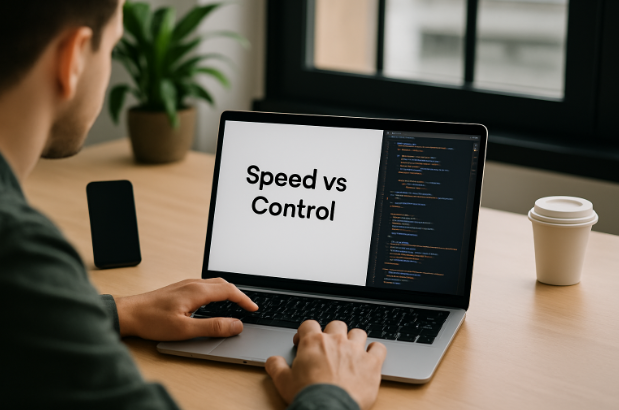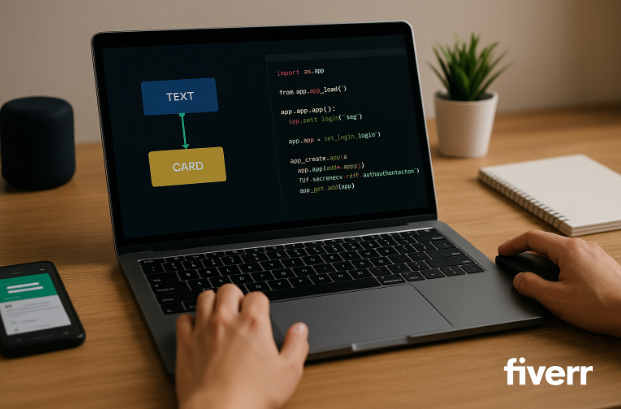
Vibe Coding workspace | speed vs. control, SaaS app, developer desk, coding efficiency.
Software development is no longer limited to writing lines of code manually. Today, businesses and individuals have options that drastically speed up app creation. Three popular approaches are Vibe Coding, Low-Code, and No-Code. Each promises faster delivery but offers different balances of control, scalability, and ease of use.
Core Differences
The first distinction is how each method works. Vibe Coding uses artificial intelligence to generate code from natural language instructions. A developer can describe the desired outcome, such as “set up a login system with JWT authentication,” and the AI produces working code. This makes it highly flexible and suited for rapid prototyping.
Low-Code platforms, explained in the low-code overview, provide visual builders alongside the ability to write custom code. They strike a balance: they are fast to use while still allowing developers to tailor applications for more complex requirements.
No-Code tools take simplicity further by offering drag-and-drop interfaces. Users can build apps without any coding knowledge at all. This makes them accessible to entrepreneurs and non-technical staff, though they often run into limitations when applications need to scale or integrate with external systems.
The vibe coding definition describes this shift as forgetting code exists. Instead of thinking in syntax, you think in plain language. This marks the main separation between Vibe Coding and its visual cousins.
Speed vs Control

Vibe Coding workspace | speed vs. control, SaaS app, developer desk, coding efficiency.
Speed is a key selling point for all three. Vibe Coding offers the fastest path from idea to working prototype, especially for teams with some technical knowledge. By contrast, Low-Code platforms offer predictable speed but require more involvement, particularly when adding integrations or advanced features.
No-Code is the quickest for complete beginners. An entrepreneur can create a simple booking app in a weekend. However, the control is minimal. Once requirements grow beyond basic features, limitations surface. Businesses often find themselves forced to migrate to Low-Code or traditional coding when they outgrow No-Code’s constraints.
In short, Vibe Coding is fastest with oversight, Low-Code is steady and adaptable, and No-Code is rapid but limited.
Security and Scale
Security is where the differences matter most. Vibe Coding, because it generates code automatically, still requires developers to review for vulnerabilities such as insecure dependencies or injection risks. It is powerful but cannot be left unchecked.
Low-Code platforms handle much of the infrastructure behind the scenes. Many vendors build compliance and scalability directly into their platforms. Yet, you are still limited to the features and security measures they provide.
No-Code tools are the least suited for large-scale or regulated applications. Most are hosted services with limited control over data protection. While fine for small projects, they rarely meet enterprise standards.
For companies handling sensitive data or working under strict regulations, careful consideration is necessary before relying on No-Code. Vibe Coding and Low-Code both offer more flexibility, but governance must be built in from the start.
Choosing the Right Approach
The decision between the three approaches should be based on your resources and goals. If your priority is to get ideas off the ground quickly while retaining the ability to refine code, Vibe Coding is the strongest option. If your organization values balance, governance, and scalability without building everything from scratch, Low-Code is a good fit. If you simply want to test an idea or build small tools without technical staff, No-Code works well.
Each approach can also complement the others. A startup might use No-Code to test a concept, shift to Vibe Coding for rapid development, and later invest in Low-Code or traditional coding for long-term growth.
Where Fiverr Fits In

Vibe Coding on Fiverr blends AI, low code, and no code for faster, smarter development.
Even with these modern approaches, human expertise remains essential. Many teams use Fiverr to connect with developers who can guide them through setup, refine user experience, or perform code audits. This mix of AI-driven speed and freelance support helps businesses stay efficient while maintaining quality. Whether you lean towards Vibe Coding, Low-Code, or No-Code, access to skilled support makes the difference between a quick launch and a sustainable product.
FAQ: Common Questions About Vibe Coding vs Low-Code vs No-Code
Q1: Is vibe coding the same as no-code?
No. Vibe Coding uses AI to generate real code from prompts, while No-Code tools rely on drag-and-drop interfaces with no code produced in the background.
Q2: Can low-code apps handle enterprise demands?
Yes. Many Low-Code platforms are designed to scale within enterprises, though some advanced integrations still require additional coding.
Q3: Which option is most cost-effective?
No-Code is cheapest to start but becomes limiting over time. Vibe Coding and Low-Code cost more initially but provide better scalability and long-term return.
Q4: Do I still need developers with vibe coding?
Yes. AI can generate code quickly, but developers are still needed to review, secure, and maintain it.
Final Thoughts
Vibe Coding, Low-Code, and No-Code represent different points on the same spectrum of faster software development. Vibe Coding gives speed and flexibility when teams can manage the output. Low-Code provides a balance of governance and adaptability. No-Code makes app creation accessible to anyone but struggles as projects grow.
The best approach depends on your situation, how fast you need to move, how much control you want, and how far you plan to scale. By weighing these factors, businesses can adopt the right strategy and avoid unnecessary roadblocks in the future.
